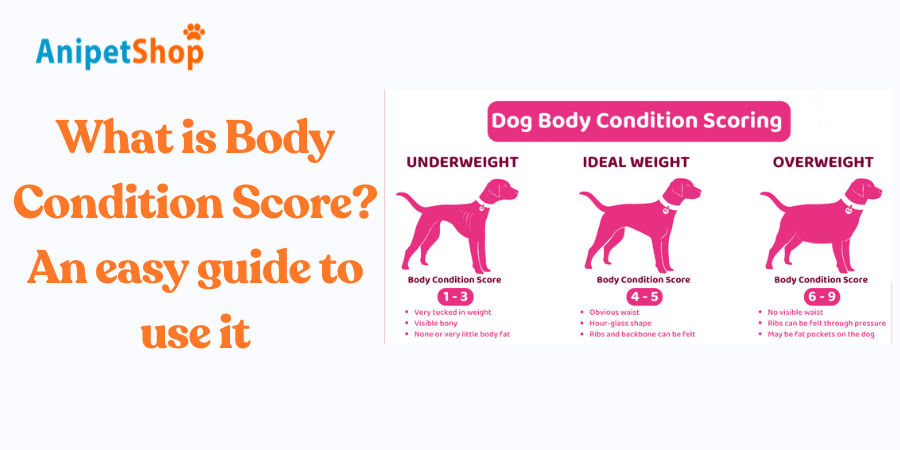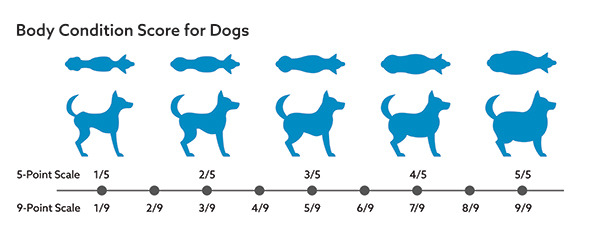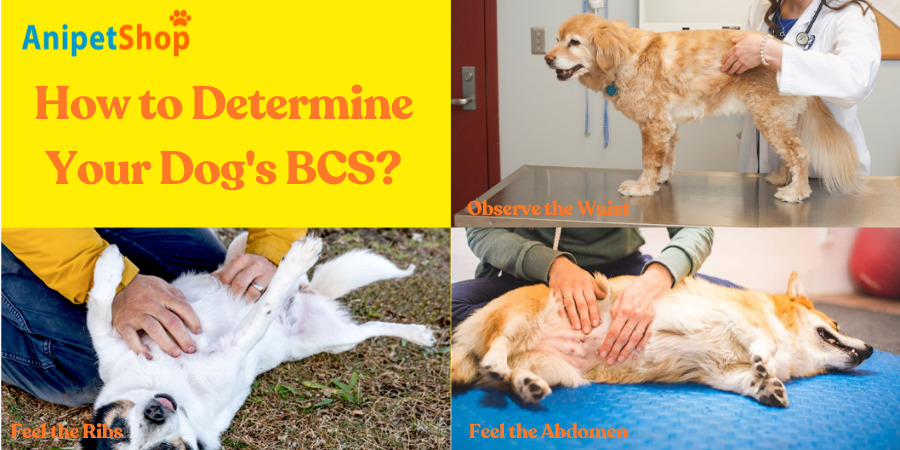How To Find Your Dog’s Body Condition Score?
Understanding your pet’s health is crucial for ensuring their well-being and longevity. One of the most effective tools for assessing your pet’s health is the Body Condition Score (BCS). This comprehensive guide will introduce you to the concept of BCS, explain its significance, and provide step-by-step instructions on how to accurately score your pet. This article will equip you with the knowledge to monitor and maintain your pet’s optimal health, ensuring they stay happy and healthy for years to come.

What is Body Condition Score (BCS)? Why use it?
The Body Condition Score (BCS) is a method used to assess the amount of fat on a dog’s body and determine their overall health. It involves both visual and tactile evaluations, allowing for a comprehensive understanding of a dog’s physical condition beyond just weight. The BCS scale typically ranges from 1 to 9, with 1 indicating an emaciated dog, 5 representing an ideal condition, and 9 showing severe obesity. This scoring system helps pet owners and veterinarians monitor and manage a dog’s health more effectively by identifying whether a dog is underweight, overweight, or at a healthy weight.
Body Condition Score (BCS) is a vital tool in veterinary medicine used to assess a dog’s health by evaluating its body fat and overall physical condition. There are two commonly used scales for BCS: the 5-point scale and the 9-point scale.
The 5-point scale ranges from 1 to 5, while the 9-point scale ranges from 1 to 9. Both scales are used to provide a standardized way to evaluate and track a dog’s body condition over time. The choice between the two scales often depends on the preference of the veterinarian or the specific protocols of the veterinary clinic:
Underweight (1-3 on 9-point scale or 1-2 on 5-point scale)
- Score 1 (Emaciated): Ribs, spine, and pelvic bones are easily visible. There is little to no discernible body fat, and the muscle mass is minimal. The dog appears very thin and frail.
- Score 2 (Very Thin): Ribs and bones are easily palpable with no fat cover. There is an obvious waist when viewed from above, and an abdominal tuck is present.
- Score 3 (Thin): Ribs are palpable without excess fat. There is a noticeable waist and abdominal tuck. The dog appears lean but not excessively thin.
Ideal (4-5 on 9-point scale or 3 on 5-point scale)
- Score 4 (Under Ideal Weight): Ribs are palpable without an excess fat covering. The waist is easily noticeable from above, and the abdomen is tucked up when viewed from the side.
- Score 5 (Ideal Weight): Ribs are palpable without being visible. There is a defined waist behind the ribs when viewed from above, and the abdomen is tucked up from the side. The dog has a healthy, well-proportioned appearance.
Overweight (6-7 on 9-point scale or 4 on 5-point scale)
- Score 6 (Slightly Overweight): Ribs are palpable with a slight excess fat cover. The waist is discernible but not as prominent. There is minimal abdominal tuck.
- Score 7 (Overweight): Ribs are palpable with difficulty due to significant fat cover. The waist is less noticeable, and there is little or no abdominal tuck. Fat deposits may be visible over the lumbar area and the base of the tail.
Obese (8-9 on 9-point scale or 5 on 5-point scale)
- Score 8 (Obese): Ribs are not palpable under a heavy fat cover. There is a significant amount of fat over the lumbar area and the base of the tail. The waist is absent, and the abdomen may appear rounded.
- Score 9 (Severely Obese): The dog has massive fat deposits over the thorax, spine, and base of the tail. There is no waist or abdominal tuck. The dog appears very heavy and has difficulty moving.

BCS is used because it provides a reliable and consistent method to assess and monitor a dog’s health. Maintaining an ideal body condition is crucial for a dog’s overall well-being. Dogs with an ideal BCS tend to live longer, healthier lives, while those that are underweight or overweight are at higher risk for a variety of health issues, including orthopedic problems, respiratory issues, diabetes, and reduced life expectancy.
How to Determine Your Dog’s BCS
Determining your dog’s Body Condition Score (BCS) needs to follow these steps:
- Feel the Ribs
Gently run your hands over your dog’s ribcage. In a dog with an ideal weight, you should be able to feel the ribs easily through a thin layer of fat. The ribs should be palpable without being overly prominent. If the ribs are very pronounced and there is minimal fat covering, the dog may be underweight. Conversely, if the ribs are difficult to feel or not palpable at all due to a thick layer of fat, the dog may be overweight.
- Observe the Waist
Look at your dog from above. An ideal weight dog will have a visible waistline just behind the ribs, creating an hourglass shape. This indentation should be noticeable but not extreme. If the waist is absent, or the dog’s body appears more oval or rectangular when viewed from above, it indicates that the dog might be overweight. On the other hand, if the waist is excessively narrow, the dog might be underweight.
- Feel the Abdomen
Gently press on your dog’s abdomen, feeling the area from the ribcage to the pelvis. In a dog with an ideal weight, the abdomen should be tucked up, not hanging or sagging. If the abdomen feels distended or saggy, it is a sign that the dog may be carrying excess weight. An abdomen that is too tucked up might suggest that the dog is underweight.

Why is BCS Important?
Maintaining an ideal Body Condition Score (BCS) is crucial for your dog’s health. Dogs that are underweight or overweight face significant health risks. Underweight dogs can suffer from malnutrition, weakened immune systems, and reduced muscle mass, making them more susceptible to infections and illnesses. On the other hand, overweight dogs are prone to a variety of chronic health problems, such as joint issues, including arthritis and hip dysplasia, due to the excess strain on their bones and joints.
The Body Condition Score (BCS) is an invaluable tool for monitoring your dog’s weight and overall health. By regularly assessing your dog’s BCS, you can detect subtle changes in their body condition that might not be noticeable with a simple weight measurement. This hands-on approach allows for early intervention if your dog begins to gain or lose weight unexpectedly, helping to prevent the development of obesity or malnutrition.
Regular BCS checks are especially important for senior dogs or those with existing health conditions. As dogs age, their metabolism slows down, and they may become less active, making them more susceptible to weight gain. Conversely, some senior dogs may lose weight due to muscle atrophy or underlying health issues. Regular BCS assessments help track these changes and adjust care plans accordingly. For dogs with chronic health conditions, maintaining an ideal BCS can significantly improve their quality of life and help manage their symptoms more effectively.
It is crucial to consult your veterinarian if you have any concerns about your dog’s BCS. If you notice significant changes in your dog’s body condition, such as rapid weight gain or loss, or if your dog consistently scores at the extreme ends of the BCS scale, it’s time to seek professional advice. Your vet can perform a comprehensive health check to identify any underlying causes and provide tailored recommendations for diet, exercise, and treatment plans.
What Is An Ideal BCS? and How to Maintain It
An ideal BCS indicates that the dog is at a healthy weight. For most breeds, this means a BCS of 4 or 5 on a 9-point scale or a BCS of 3 on a 5-point scale. Puppies and young dogs should have a BCS that reflects their high energy levels and growth needs. They often have a slightly higher fat cover to support growth. Adult dogs should maintain a stable ideal BCS, with clear waist definition and easily palpable ribs. Senior dogs may have slightly more body fat due to reduced activity levels, but it’s crucial to prevent obesity as it can exacerbate age-related health issues such as arthritis.
Maintaining an ideal BCS involves a combination of proper diet, exercise, and portion control. Here are some tips:
- Balanced Diet Appropriate for Breed, Age, and Activity Level
Feeding your dog a balanced diet that is suitable for their breed, age, and activity level is crucial. Different breeds have varying metabolic rates and nutritional needs. For example, a high-energy breed like a Border Collie will require more calories and different nutrient ratios compared to a less active breed like a Bulldog. Puppies need food that supports growth, while senior dogs may benefit from diets that are lower in calories but higher in fiber to support digestive health. Consulting your veterinarian can help you choose the right diet for your dog’s specific needs.
- Regular Exercise
Regular exercise is essential for maintaining a healthy weight and overall health. The type and amount of exercise should match your dog’s breed and age. Active breeds like Labrador Retrievers or German Shepherds require more vigorous and frequent exercise, such as running or agility training, whereas less active breeds may only need daily walks. Exercise helps burn calories, build muscle, and keep your dog mentally stimulated.
- Portion Control
Portion control is vital to prevent overfeeding, which can lead to weight gain. Use a measuring cup to ensure you are feeding the correct amount based on your dog’s weight, age, and activity level. Many dog food packages provide feeding guidelines, but these are often general recommendations. Adjust the portions based on your dog’s specific needs and monitor their weight regularly to ensure they stay within the ideal BCS range.
- Avoiding Table Scraps and Excessive Treats
Table scraps and excessive treats can quickly add unnecessary calories to your dog’s diet. Human food often contains ingredients that are not suitable for dogs and can lead to weight gain and other health issues. Instead, reward your dog with low-calorie treats or healthy alternatives like baby carrots or apple slices. Ensure treats make up no more than 10% of your dog’s daily caloric intake.
- Encouraging Gradual Weight Loss or Gain
If your dog needs to lose or gain weight, it’s important to do so gradually. Rapid weight changes can be harmful. For weight loss, reduce the calorie intake slowly and increase physical activity. For weight gain, increase the portion size gradually and choose nutrient-dense foods. Always consult your veterinarian before making significant changes to your dog’s diet or exercise routine to ensure it is safe and effective.
What Is a Bad Body Condition Score for Dogs?
A bad Body Condition Score (BCS) for dogs can indicate that the dog is either underweight or overweight, both of which can have serious health implications. BCS is measured on a scale of 1 to 9, where scores at the extremes (1-3 or 7-9) are considered unhealthy.
A BCS of 1 to 3 signifies that a dog is underweight:
- BCS 1 (Emaciated): At this level, the dog’s ribs, spine, and pelvic bones are easily visible, with little to no body fat and minimal muscle mass. This condition is often accompanied by visible loss of muscle and a sunken appearance.
- BCS 2 (Very Thin): The dog’s ribs and bones are palpable with no fat covering. There is an obvious waist when viewed from above, and the abdomen is tucked up from the side.
- BCS 3 (Thin): The ribs are easily felt with minimal fat covering. There is a noticeable waist and an abdominal tuck. Although the dog appears lean, it is not as severely thin as with a BCS of 1 or 2.
Underweight dogs may suffer from malnutrition, weakened immune systems, and reduced muscle mass, making them more susceptible to infections, illnesses, and poor overall health.
A BCS of 7 to 9 indicates that a dog is overweight to obese:
- BCS 7 (Overweight): The ribs are palpable with difficulty due to a significant fat cover. The waist is less noticeable, and there is little or no abdominal tuck. Fat deposits may be visible over the lumbar area and the base of the tail.
- BCS 8 (Obese): Ribs are not palpable under a heavy fat cover. There is a significant amount of fat over the lumbar area and the base of the tail. The waist is absent, and the abdomen may appear rounded.
- BCS 9 (Severely Obese): The dog has massive fat deposits over the thorax, spine, and base of the tail. There is no waist or abdominal tuck. The dog appears very heavy and may have difficulty moving.
Conclusion
the Body Condition Score (BCS) is a vital tool for assessing and maintaining your dog’s health. It provides a clear and consistent method to determine whether your dog is underweight, overweight, or at an ideal weight. Regularly assessing your dog’s BCS can help you detect weight-related issues early, allowing for timely interventions to ensure your dog remains healthy.
Maintaining a healthy weight is crucial for your dog’s overall well-being, reducing the risk of chronic health issues such as joint problems, diabetes, and heart disease. By using BCS, you can make informed decisions about your dog’s diet, exercise, and care routines, promoting a longer, happier life for your pet.
Lily Watson is an author specializing in veterinary care in Australia. With a profound passion for animal welfare and a solid foundation in veterinary science, Lily has dedicated herself to disseminating valuable knowledge and information for both pet owners and professionals in this field.

